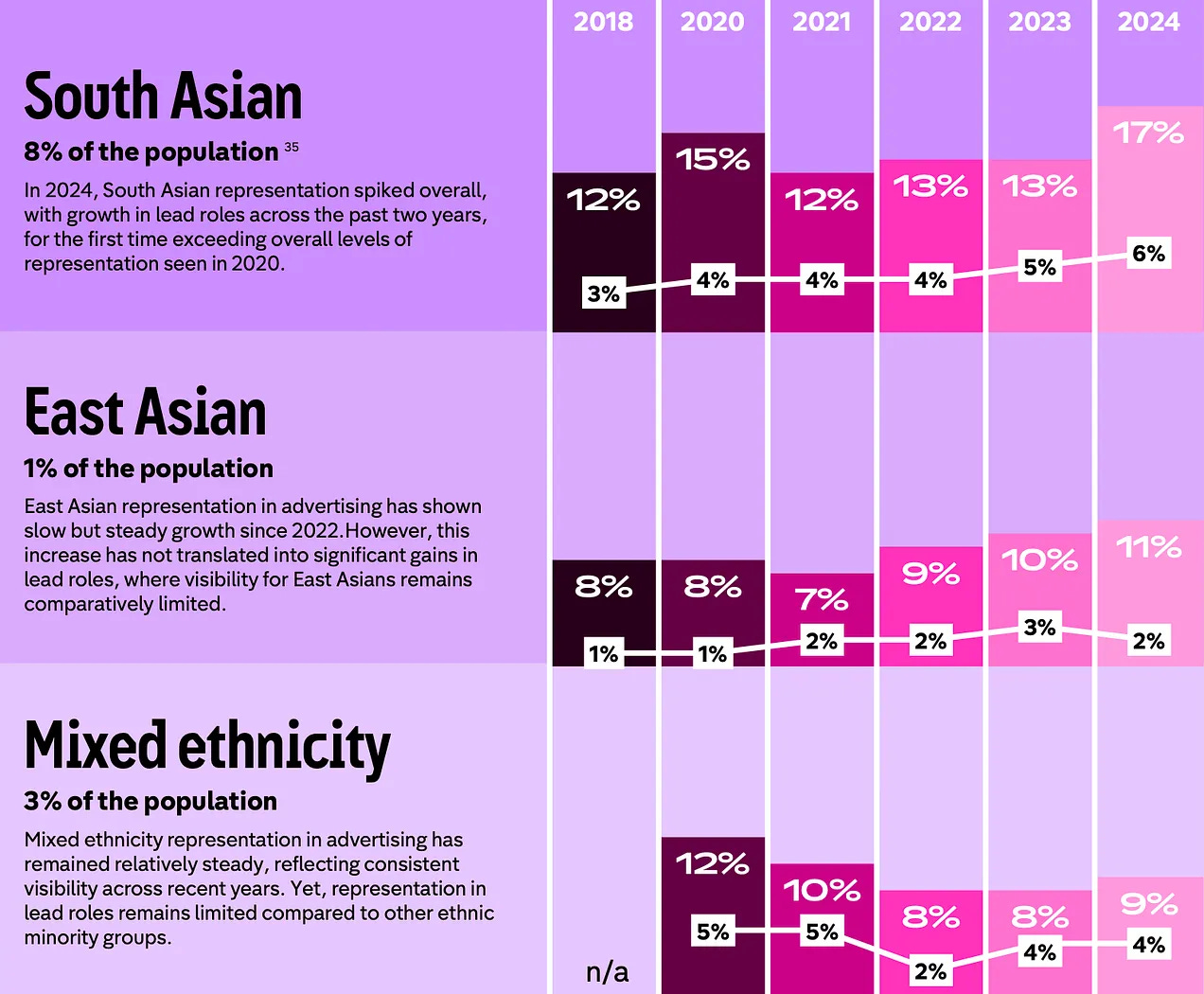No, Sarah Pochin - There Aren’t “Too Many” Brown People on TV
When racists start citing research, you know the point’s been lost. The “evidence” used to defend Pochin proves the exact opposite of what they think.
Welcome to Bearly Politics - where I attempt to separate fact from farce in Britain’s ongoing identity crisis. I’m The Bear, and today I’m discussing some data that’s been twisted into yet another excuse for casual racism - this time, courtesy of Reform’s Sarah Pochin and a Times headline about adverts.
Everyone should by now be aware of the fact that Sarah Pochin, Reform MP, has made it very clear that representation of Black and Asian people on the telly drives her “mad” - and, very importantly, that this is 100% racist.

There has been an “apology” from Pochin herself (the standard “I’m sorry if you’re offended” rather than “I’m sorry that I’m a racist,” but hey-ho), and a defence from Zia Yusuf (presumably issued between writing resignation letters), and all that has been rather par for the course these days. This morning though, a new defence was brought up on Nick Ferrari’s show – the claim that while what she said was, indeed, unacceptable, it is unfortunately supported by the evidence.
What sort of evidence, you ask?
That would be a Times article (behind a paywall, obviously) published at the beginning of October that lamented that “Adverts over-represent black people while ignoring over-70s” which was in turn based on a report that was published at the end of September by Tapestry in partnership with Channel 4.
The report has been running since circa 2019 and has become something of a benchmark for how inclusive (or otherwise) the world of advertising in the UK actually is.
And here’s the thing - the report did in fact find that 51% of adverts now “feature” a Black person when compared to around the 4% of representation in the UK population for Black people.
This, not unexpectedly, led at the time to the peals of “OVERREPRESENTATION” by the Times, Daily Mail and the usual suspects which in turn led to a good old round of self-satisfied head-nodding from people who are desperate to believe that progress is just another form of oppression.
Except, of course, there is far more nuance to this than just that one data point (isn’t there always?)
The first thing to point out is that the Mirror on the Industry doesn’t measure dominance - it measures visibility. An advert that “features” a Black person doesn’t mean that they’re the start, storyteller or even meaningfully present - it could be something as simple as a single Black face passing in the background of a super-market montage or “a darker skinned hand reaching for a product before the logo flashes up” as described by Benjamin Hiorns from Creative Pool, because a single frame counts.
The report itself notes that 87% of ads they identified had “tokenistic inclusion” and were generally speaking montage ads - the ones that shove dozens of quick cuts into 30 seconds. In these ads, minority characters have minimal screen time, they rarely speak and are quite often turned away, obscured or out of focus.
This creates an issue for people like Ferrari or Pochin’s apologists who point to the “51% of ads” figure - and that issue is that they’re pointing out the illusion of diversity on screen and not actual diversity itself.
The Audit calls it the “Montage Effect” - a tendency for brands to sprinkle in visible difference like a bit of diversity seasoning instead of actually changing the dish being served up.
I would also add that if you had a look at the rest of the report (which I can guarantee you now that most of the people using it as “evidence” to excuse or explain Pochin’s racism), it becomes pretty clear pretty quickly that the problem isn’t “too many Black and Asian people on the telly” - the problem is that when they do appear, they’re rarely more than background noise.
The visualisations below (not yet public and shared with me by a contact of mine in the advertising industry) are helpful in understanding this:
The graph above shows that yes, while 51% of ads “feature” Black people in any capacity, only 23% of those adverts actually have them in lead roles.
The same is true when it comes to Asian representation - while 17% of ads my feature people of South Asian heritage, it’s only in 6% of those adverts that they’re given lead roles.
So yes, Sarah Pochin might see them (and presumably chuck a mug at the telly, depending on just how “mad” she gets), but she’s not seeing them - certainly not as main characters or as ordinary Britons with narrative agency of any real sort and they’re usually there to decorate someone else’s story.
There also seems to be this idea that inclusion is crowding everyone else out - and if Pochin and her fans want to get into the numbers game, it’s worth taking a glance at the other categories that the report examined.
Disabled people who make up around a quarter of the adult population in the UK appeared in just 2% of adverts - and that’s a number that hasn’t really moved since 2018. To make things more complicated on this front, when they do appear they’re about eight times more likely to be in an ad that is serious or emotive instead of a product ad, basically translating into them being framed as inspirational case studies rather than everyday consumers.
The other cohort is pregnant women - they appeared in fewer than 0.1% of ads, this in a country with nearly 600,000 births in 2024. According to advertising agencies, pregnancy may as well be a mythological event.
People aged 70 and over, which at this stage make up about 14% of the population, appeared in just 2% of adverts and were usually found flogging painkillers or stairlifts and, pretty crucially, were 34% less likely to be portrayed as confident or happy.
Working class people? They’re rarely portrayed as confident or aspiration - and this is true for working class people of any colour.
Instead of being a warning sign that Black and Asian people are overrepresented on our tellies, the Mirror on the Industry reads like a study in a sort of collective amnesia and that the entire commercial sector seems to believe that the only people worth selling to are young, thin, non-disabled and under 50.
It’s maddening to me that the one sliver of visible progress - a slight uptick in Black and Asian people in ads - is being seized on by racists as a proof of some sort of ideological takeover instead of an acknowledgement of what it is - a partial and incomplete correction that still leaves the majority of marginalised people invisible.
Somewhat predictably, The Times article flattened out all the nuance into a headline about “overrepresentation” and did so by equating “featured in ad” with “dominating the airwaves” and continuing their reporting of numbers without narrative, meaning it was ultimately meaningless. It also baffles me that there is this idea that every group and cohort should appear in advertising in a strict and unmovable proportion to its population and that there’s an assumption that the natural state of the media should mirror a census table rather than a living culture.
And even if the numbers are going higher - so bloody what? What’s actually being shown?
The Head of the Film and TV Charity, Marcus Ryder also pointed out that whenever black people do appear, they’re often selected for traits that advertisers find “sexy or fashionable” and that lighter-skinned actors dominated while darker skinned women are almost entirely missing.
The funniest (and by funniest I mean damned bleak) part of this whole story is how Pochin’s excusers have used a report that has literally called out “tokenism” as their proof that there are too many brown people on the telly. The report didn’t read that there are too many Black and Asian people on tv - it read that there are too few authentic portrayals and that we should all be sick of montage inclusion being used as a diversity fig leaf.
They specifically called for storytelling that’s rooted in lived experiences, for advertisers to push themselves past safe cliches we’ve gotten so used to and to represent real people in real context - yet somehow this has turned into reactionaries arriving en masse, waving an Executive Summary around like a get-out-of-racism-free-card.
The biggest thing that Pochin’s outburst at her inability to control her feelings toward brown faces on the telly reveals - and the use of “data” to defend these views - is that this isn’t about representation or statistics at all - it’s about discomfort.
It’s all about which people that live in this country get to be ordinary. Because this is what’s slowly changing - Black and Asian people are slowly being moved from just being cast as sidekicks or exotic props - they’re appearing more and more as normal citizens of this country doing what normal citizens of this country do, like eating cereal, buying broadband, arguing over a dinner table and maybe driving a car. That normalcy will, for a certain cohort of people in this country feel like intrusion, because when you’ve grown up seeing yourself reflected everywhere, allowing other people into the picture will feel like erasure.
It’s also not lost on me that there’s a bit of irony at play here when racists suddenly become defenders of empirical research - because when the data supports their bigotry (or they torture it until it appears to), it’s objective truth. But the moment it doesn’t - like let’s say for example when every serious economist points out that Brexit has gutted the economy for years - it’s “biased elites manipulating statistics.” Funny how that works, isn’t it?
The long and short of this saga is that the claim that Black and Asian people are “overrepresented” in advertising collapses under its own logic, and even more so when you start asking questions. Questions like how they’re overrepresented in the media? By seconds on screen? Product categories? Actual storylines? Because, as ever, the people who shout most loudly about “evidence” seem completely unable to define the unit of measurement.
And as soon as you drill into what the report actually measures - presence, not domination or power - the argument disintegrates completely. Poof.
The numbers given by Mirror on the Industry don’t prove that Black and Asian people are everywhere - it proves that they’re still being used as decorative shorthand for “Modern Britain” and not yet being treated as fully equal in their narrative.
The report shows that the UK is inching - painfully slowly - towards a more honest reflection of itself, and that honesty can cause discomfort to people who have only ever seen themselves centred, leading them to reach for that final refuge of the perma-resentful: “It’s just gone too far.”
It really, really hasn’t - and if anything, it has a good measure of distance left to go. Because until older, disabled, pregnant, queer, brown and working class people all appear on our telly as comfortably, unremarkably and fully as everyone else, we’ll still be dealing with a mirror showing us an image that’s not entirely true to our lives we live.
If you appreciated this little deep dive into how racism keeps trying to disguise itself as “data,” you’ll probably enjoy the rest of Bearly Politics - where I spend a frankly worrying amount of time dismantling moral panics in spreadsheet form.
Subscribe for free, or support with a paid subscription if you can - I do this without a billionaire backer (and Mr Soros still isn’t returning my calls).
If not, a share is just as good.
Further Reading:







The problem is too many Reform faces on TV. Four MPs and 50% of the MSM coverage
Spot on as usual. It’s not representation that makes Sarah Pochin furious. It’s the loss of control. She’s used to seeing Britain through a narrow keyhole: a world where ordinary life looks like her living room, everyone else just extras.
Advert panels, diversity reports, stats — none of it matters. What she’s really afraid of is ordinary people actually being ordinary on screen: Black, Asian, older, working-class, disabled, queer. People living normal lives without a script telling them how to look, speak, or move.
Pochin’s meltdown is a reminder that inclusion isn’t about numbers; it’s about power. Who gets to be seen as “default”? Who gets to occupy narrative space without permission? And she’s losing that battle, one advert at a time.